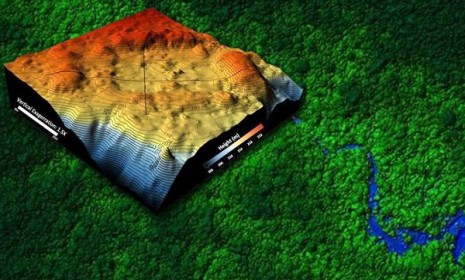Discovered: Honduras' mythical city of gold?
Conquistadors like Hernando Cortes in the 1500s searched endlessly for the ancient city and its purported riches. Now modern researchers think they've found it

Deep in the rainforest of Honduras' Mosquitia region, archaeologists have discovered what they think might be the remains of La Ciudad Blanca, which, according to legend, is thought to be brimming with gold. But the discovery of the mystical White City is far from Indiana Jones-esque (at least so far) — for example, researchers had to use sophisticated modern technologies from the safety of a plane to pinpoint its location. Here's what you should know:
What exactly is La Ciudad Blanca?
Legend has it that the lost city was once full of gold, which is why conquistadors like Hernando Cortes searched far and wide for it in the 1500s. Rumored sightings throughout the centuries "have described golden idols and elaborately carved white stones," hence the White City's namesake, says The Daily Mail. According to folklore, La Ciudad Blanca is the birthplace of the Aztec deity Quetzalcoatl, a serpent-like creature with feathers. Now, researchers think they've honed in on La Ciudad Blanca's precise location.
The Week
Escape your echo chamber. Get the facts behind the news, plus analysis from multiple perspectives.

Sign up for The Week's Free Newsletters
From our morning news briefing to a weekly Good News Newsletter, get the best of The Week delivered directly to your inbox.
From our morning news briefing to a weekly Good News Newsletter, get the best of The Week delivered directly to your inbox.
How did they find it?
Instead of "hacking through forests using machetes," researchers employed a modern day technology called LiDAR, says Innovation News Daily. The technology works like sonar: Quick-burst laser pulses bounce off the ground below at a rate of 100,000 per second. The time it takes for the light to return to the plane tells researchers the altitude points on the ground, allowing them to put together a topographic map through the tree cover.
Why use that technology?
LiDAR isn't just cheaper and safer than embarking on expeditions by foot, but it also allows researchers to cover more ground. In 2009, a separate archaeology team from the U.S. used LiDAR to analyze more than 80 square miles of forests in Belize. The technology has been gaining traction ever since.
A free daily email with the biggest news stories of the day – and the best features from TheWeek.com
What did the team actually see in this case?
The project, led by Steven Elkins of the National Science Foundation, analyzed three areas considered promising. Engineers flew over 60 square miles of forest in Honduras' Mosquitia region and beamed that data back to Elkins, who worked from an outpost thousands of miles away in West Virginia. After looking at the data for five minutes, he spotted what appeared to be human-made structures. Honduran archaeologists confirmed that they were in fact man-made.
What's next?
Elkins will make the trek by foot to evaluate the structures. "That journey will not be an easy one," says Kraig Becker at Gadling, but what he finds will likely "be a fabulous discovery, with or without the gold."
Is LiDAR the future?
It certainly seems like it. Equipping robotic drones with LiDAR, for example, could help map unexplored regions of the Arctic, or even be used to assess conditions after earthquakes or hurricanes. In theory, says LiDAR engineer Bill Carter, these systems could be used to "map the entire Earth."
Sources: Daily Mail, Gadling, Innovation News Daily
-
 Why recognizing Somaliland is so risky for Israel
Why recognizing Somaliland is so risky for IsraelTHE EXPLAINER By wading into one of North Africa’s most fraught political schisms, the Netanyahu government risks further international isolation
-
 Crossword: December 30, 2025
Crossword: December 30, 2025The daily crossword from The Week
-
 What have Trump’s Mar-a-Lago summits achieved?
What have Trump’s Mar-a-Lago summits achieved?Today’s big question Zelenskyy and Netanyahu meet the president in his Palm Beach ‘Winter White House’